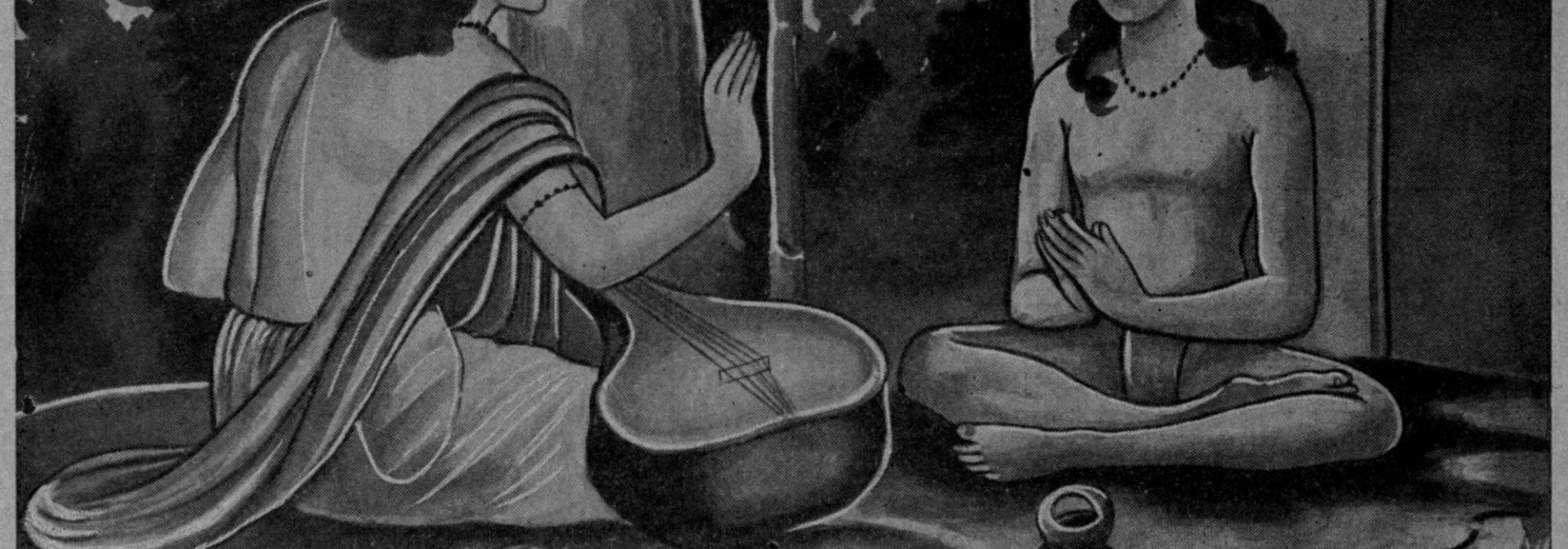दुस्सङ्गः सर्वथैव त्याज्यः । ४३
43. Always avoid bad company.
कामक्रोधमोहस्मृतिभ्रंशबुद्धिनाशकारणत्वात् । ४४
44. It (evil company) is the cause for lust, anger, attachment, decline of learning, and the destruction of the intellect.
तरङ्गायिता अपीमे सङ्गात् समुद्रायन्ते । ४५
45. The ripples (of lust, anger, attachment, etc.) take the form of the ocean because of such company.
कस्तरति कस्तरति मायाम् यः सङ्गं त्यजति यो महानुभावं सेवते निर्ममो भवति । ४६
46. Who transcends, who transcends maya? One who abandons attachments, serves great people, and is free from a sense of ‘I.’
[Maya (literally means ‘illusion,’ ‘deception,’ ‘jugglery’) is the inexplicable power of the divine. It can also refer to the temporary state of experiential being.]
यो विविक्तस्थानं सेवते यो लोकबन्धमुन्मूलयति निस्त्रैगुण्यो भवति योगक्षेमं त्यजति । ४७
47. One who inhabits a secluded place and breaks all worldly bonds is free from the three gunas and abandons all thought of personal comfort and welfare.
[Guna = trait, characteristic, quality. The three gunas are sattva (saintly goodness), rajas (relentless activity), and tamas (deluded lethargy). While sattva is better than rajas, which is better than tamas, the ideal is to transcend all three gunas; see Bhagavad-Gita 2.45]
यः कर्मफलं त्यजति कर्माणि संन्यस्स्यति ततो निर्द्वन्द्वो भवति । ४८
48. One who gives up the rewards of action and is unattached to action becomes free of dichotomies.
[To ‘give up the rewards of action’ merely refers to focusing on the work without getting attached to it or to the possible results. The Bhagavad-Gita says, “You can control only your actions; you can’t control the results. The expected results should not be the motivation for action. Also, don’t shirk away from your work.” (BG 2.47)
Here, ‘dichotomies’ refers to the pairs of opposite like heat and cold, pleasure and pain, praise and criticism, joy and sorrow, etc.]
यो वेदानपि संन्यस्यति केवलमविच्छिन्नानुरागं लभते । ४९
49. One who renounces even the Vedas attains the sole, eternal love (of the Supreme).
स तरति स तरति स लोकांस्तारयति । ५०
50. He transcends, he transcends (maya) and helps the world transcend it.
अनिर्वचनीयं प्रेमस्वरूपम् । ५१
51. The form of love can’t be described in words.
मूकास्वादनवत् । ५२
52. (It is) like a mute person (trying to describe) a wonderful taste.
प्रकाशते क्वापि पात्रे । ५३
53. Sometimes, in capable people, it finds expression.
गुणरहितं कामनारहितं प्रतिक्षणवर्धमानं अविच्छिन्नं सूक्ष्मतरं अनुभवरूपम् । ५४
54. (This love) is free of gunas, without expectations, constantly growing every second, ceaseless, subtle, and in the form of experience.
तत्प्राप्य तदेवावलोकति तदेव शृणोति तदेव भाषयति तदेव चिन्तयति । ५५
55. Having attained it (love), that becomes one’s outlook; one hears only that, speaks only about that, and thinks only of that.
गौणी त्रिधा गुणभेदाद् आर्तादिभेदाद् वा । ५६
56. There are three kinds of secondary (love) divided according to gunas – devotion arising from distress, etc.
[The three kinds of secondary devotion are aligned to the three gunas – a devotee who ‘seeks wisdom’ is linked to ‘sattva,’ a devotee who ‘craves for wealth’ is linked to ‘rajas,’ and a devotee who ‘prays only in times of distress’ or ‘begs for the destruction of others’ is linked to ‘tamas.’]
उत्तरस्मादुत्तरस्मात् पूर्व पूर्वा श्रेयाय भवति । ५७
57. (Of these three types) every preceding type is better than its successor.
[Of these three secondary modes of devotion, worship for the sake of attaining wisdom is better than rituals to gain wealth, which is in turn better than prayer to fulfil selfish desires.]
अन्य मात् सौलभं भक्तौ । ५८
58. Bhakti is the easiest of all (paths).
प्रमाणान्तरस्यानपेक्षत्वात् स्वयं प्रमाणत्वात् । ५९
59. The proof (for bhakti) lies within itself; it needs no other evidence.
शान्तिरूपात् परमानन्दरूपाच्च । ६०
60. It is of the form of peace and supreme bliss.
लोकहानौ चिन्ता न कार्या निवेदितात्मलोकवेदत्वात् । ६१
61. One should not worry about worldly failures, having offered (to the Supreme) (all) worldly and spiritual actions.
न तत्सिद्धौ लोकव्यवहारो हेयः किन्तु फलत्यागः तत्साधनं च । ६२
62. Don’t abandon worldly actions until perfection is attained; however, continue the practice of giving up the rewards of action.
स्त्रीधननास्तिकचरित्रं न श्रवणीयम् । ६३
63. Don’t listen to discussions about the character of women, wealth, and non-believers.
I'm grateful to Shatavadhani Dr. R. Ganesh for his review of my translation. The translations of the Gita are taken from The New Bhagavad-Gita, which I co-wrote with Dr. Koti Sreekrishna.















































